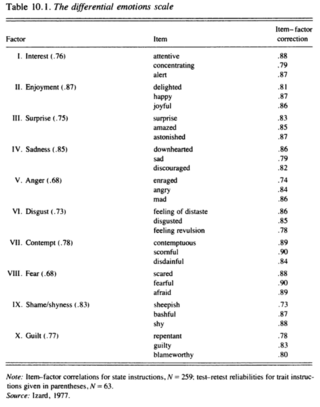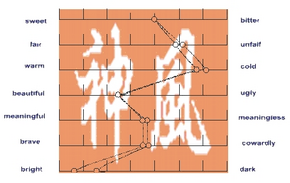
Psychometrics is a field of study within psychology concerned with the theory and technique of measurement. Psychometrics generally refers to specialized fields within psychology and education devoted to testing, measurement, assessment, and related activities. Psychometrics is concerned with the objective measurement of latent constructs that cannot be directly observed. Examples of latent constructs include intelligence, introversion, mental disorders, and educational achievement. The levels of individuals on nonobservable latent variables are inferred through mathematical modeling based on what is observed from individuals' responses to items on tests and scales.
Semantics is the study of reference, meaning, or truth. The term can be used to refer to subfields of several distinct disciplines, including philosophy, linguistics and computer science.
Psycholinguistics or psychology of language is the study of the interrelation between linguistic factors and psychological aspects. The discipline is mainly concerned with the mechanisms by which language is processed and represented in the mind and brain; that is, the psychological and neurobiological factors that enable humans to acquire, use, comprehend, and produce language.

Psychological testing is the administration of psychological tests. Psychological tests are administered by trained evaluators. A person's responses are evaluated according to carefully prescribed guidelines. Scores are thought to reflect individual or group differences in the construct the test purports to measure. The science behind psychological testing is psychometrics.

Rensis Likert was an American organizational and social psychologist known for developing the Likert scale, a psychometrically sound scale based on responses to multiple questions. The scale has become a method to measure people's thoughts and feelings from opinion surveys to personality tests. Likert also founded the theory of participative management, which is used to engage employees in the workplace. Likert's contributions in psychometrics, research samples, and open-ended interviewing have helped form and shape social and organizational psychology.
In the social sciences, scaling is the process of measuring or ordering entities with respect to quantitative attributes or traits. For example, a scaling technique might involve estimating individuals' levels of extraversion, or the perceived quality of products. Certain methods of scaling permit estimation of magnitudes on a continuum, while other methods provide only for relative ordering of the entities.

In psychology, attitude is a psychological construct that is a mental and emotional entity that inheres or characterizes a person, their attitude to approach to something, or their personal view on it. Attitude involves their mindset, outlook and feelings. Attitudes are complex and are an acquired state through life experience. Attitude is an individual's predisposed state of mind regarding a value and it is precipitated through a responsive expression towards oneself, a person, place, thing, or event which in turn influences the individual's thought and action.

A Likert scale is a psychometric scale commonly involved in research that employs questionnaires. It is the most widely used approach to scaling responses in survey research, such that the term is often used interchangeably with rating scale, although there are other types of rating scales.
In psychology and sociology, the Thurstone scale was the first formal technique to measure an attitude. It was developed by Louis Leon Thurstone in 1928, as a means of measuring attitudes towards religion. It is made up of statements about a particular issue, and each statement has a numerical value indicating how favorable or unfavorable it is judged to be. People check each of the statements to which they agree, and a mean score is computed, indicating their attitude.
Customer satisfaction is a term frequently used in marketing. It is a measure of how products and services supplied by a company meet or surpass customer expectation. Customer satisfaction is defined as "the number of customers, or percentage of total customers, whose reported experience with a firm, its products, or its services (ratings) exceeds specified satisfaction goals." Customers play an important role and are essential in keeping a product or service relevant; it is, therefore, in the best interest of the business to ensure customer satisfaction and build customer loyalty.
A rating scale is a set of categories designed to elicit information about a quantitative or a qualitative attribute. In the social sciences, particularly psychology, common examples are the Likert response scale and 1-10 rating scales in which a person selects the number which is considered to reflect the perceived quality of a product.
In statistics, scale analysis is a set of methods to analyze survey data, in which responses to questions are combined to measure a latent variable. These items can be dichotomous or polytomous. Any measurement for such data is required to be reliable, valid, and homogeneous with comparable results over different studies.
The visual analogue scale (VAS) is a psychometric response scale that can be used in questionnaires. It is a measurement instrument for subjective characteristics or attitudes that cannot be directly measured. When responding to a VAS item, respondents specify their level of agreement to a statement by indicating a position along a continuous line between two end points.
The Sixteen Personality Factor Questionnaire (16PF) is a self-report personality test developed over several decades of empirical research by Raymond B. Cattell, Maurice Tatsuoka and Herbert Eber. The 16PF provides a measure of personality and can also be used by psychologists, and other mental health professionals, as a clinical instrument to help diagnose psychiatric disorders, and help with prognosis and therapy planning. The 16PF can also provide information relevant to the clinical and counseling process, such as an individual's capacity for insight, self-esteem, cognitive style, internalization of standards, openness to change, capacity for empathy, level of interpersonal trust, quality of attachments, interpersonal needs, attitude toward authority, reaction toward dynamics of power, frustration tolerance, and coping style. Thus, the 16PF instrument provides clinicians with a normal-range measurement of anxiety, adjustment, emotional stability and behavioral problems. Clinicians can use 16PF results to identify effective strategies for establishing a working alliance, to develop a therapeutic plan, and to select effective therapeutic interventions or modes of treatment. It can also be used within other areas of psychology, such as career and occupational selection.
Impression formation in social psychology refers to the processes by which different pieces of knowledge about another are combined into a global or summary impression. Social psychologist Solomon Asch is credited with the seminal research on impression formation and conducted research on how individuals integrate information about personality traits. Two major theories have been proposed to explain how this process of integration takes place. The Gestalt approach views the formation of a general impression as the sum of several interrelated impressions. As an individual seeks to form a coherent and meaningful impression of another individual, previous impressions significantly influence the interpretation of subsequent information. In contrast to the Gestalt approach, the cognitive algebra approach asserts that individuals' experiences are combined with previous evaluations to form a constantly changing impression of a person. A related area to impression formation is the study of person perception, making dispositional attributions, and then adjusting those inferences based on the information available.
In social identity theory, an implicit bias or implicit stereotype, is the pre-reflective attribution of particular qualities by an individual to a member of some social out group.

The Differential Emotions Scale (DES) is a multidimensional self-report device for assessment of an individual's emotions. The DES helps measure mood based on Carroll Izard's differential emotions theory, The DES consists of thirty items, three for each of the ten fundamental emotions as visualized by Izard: interest, joy, surprise, sadness, anger, disgust, contempt, fear, shame/ shyness, and guilt, which are represented on 5-point Likert scale. There are currently four different versions of the scale. Despite the different versions, the basic idea of are very similar. Participants are asked to rate each of the emotions on a scale, and depending on the instructions given, they either rate their current feelings, feelings over the past week, or over long-term traits. The DES is similar to other scales such as the Multiple Affect Adjective Check List (MAACL) and the Multiple Affect Adjective Check List-Revised (MAACL-R) which are used to assess either the state or trait affect by varying the time of which instructions are given to the participants.
Charles Egerton Osgood was an American psychologist and professor at the University of Illinois. He was known for his research on behaviourism versus cognitivism, semantics, cross-culturalism, psycholinguistic theory, and peace studies. He is credited with helping in the early development of psycholinguistics. Charles Osgood was recognized distinguished and highly honored psychologist throughout his career.
Affective priming, also called affect priming, is a type of response priming and was first proposed by Russell H. Fazio. This type of priming entails the evaluation of people, ideas, objects, goods, etc., not only based on the physical features of those things, but also on affective context. The affective context may come from previous life experiences, and therefore, primes may arouse emotions rather than ideas. Most research and concepts about affective priming derive from the affective priming paradigm, which looks to make judgments of neutral affective targets following positive, neutral, or negative primes. A prominent derivation of affective priming paradigm is the Affect Misattribution Procedure (AMP), developed by Payne, Cheng, Govorun, and Stewart. The main idea of AMP is to measure implicit attitudes, therefore, if the evaluation of the prime stimuli of an object is positive, it is said that the person has a positive attitude toward the object exposed.
Semantics within psychology is the study of how meaning is stored in the mind. Semantic memory is a type of long-term declarative memory that refers to facts or ideas which are not immediately drawn from personal experience. It was first theorized in 1972 by W. Donaldson and Endel Tulving. Tulving employs the word semantic to describe a system of memory that involves “words and verbal symbols, their meanings and referents, the relations between them, and the rules, formulas, or algorithms for influencing them”.





